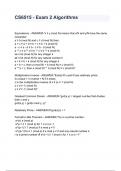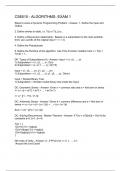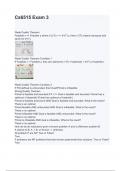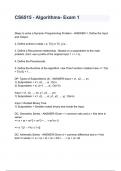Cs6515 algorithms exam - Study guides, Class notes & Summaries
Looking for the best study guides, study notes and summaries about Cs6515 algorithms exam? On this page you'll find 21 study documents about Cs6515 algorithms exam.
Page 2 out of 21 results
Sort by
CS6515 - Exam 2 Algorithms with complete solution
CS6515 - Algorithms- Exam 1
CS6515 - Algorithms- Exam bundle
CS6515 /CS 6515 (ALGORITHMS) 1,2,3 AND FINAL EXAM 4 DIFFERENT VERSION WIT ACTUAL QUESTIONS AND CORRECT ANSWERS
CS6515 - Algorithms- Exam 1 with complete solution
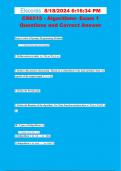
-
CS6515 - Algorithms- Exam 1 Questions and Correct Answer
- Exam (elaborations) • 23 pages • 2024
-
- $10.49
- + learn more
CS6515 - Algorithms- Exam 1 Questions and Correct AnswerCS6515 - Algorithms- Exam 1 Questions and Correct AnswerCS6515 - Algorithms- Exam 1 Questions and Correct AnswerCS6515 - Algorithms- Exam 1 Questions and Correct AnswerCS6515 - Algorithms- Exam 1 Questions and Correct AnswerCS6515 - Algorithms- Exam 1 Questions and Correct AnswerCS6515 - Algorithms- Exam 1 Questions and Correct AnswerCS6515 - Algorithms- Exam 1 Questions and Correct AnswerCS6515 - Algorithms- Exam 1 Questions and C...
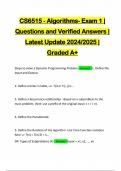
-
CS6515 - Algorithms- Exam 1 | Questions and Verified Answers | Latest Update 2024/2025 | Graded A+
- Exam (elaborations) • 19 pages • 2024
- Available in package deal
-
- $12.49
- + learn more
CS6515 - Algorithms- Exam 1 | Questions and Verified Answers | Latest Update 2024/2025 | Graded A+ Steps to solve a Dynamic Programming Problem - Answer -1. Define the Input and Output. 2. Define entries in table, i.e. T(i) or T(i, j) is... 3. Define a Recurrence relationship - Based on a subproblem to the main problem. (hint: use a prefix of the original input 1 < i < n). 4. Define the Pseudocode. 5. Define the Runtime of the algorithm. Use Time Function notation here => T(n...
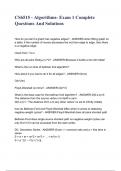
-
CS6515 - Algorithms- Exam 1 Complete Questions And Solutions latest
- Exam (elaborations) • 24 pages • 2024
-
Available in package deal
-
- $7.99
- + learn more
How do you tell if a graph has negative edges? - ANSWER-when fitting graph on a table, if the number of moves decreases the w() from edge to edge, then there is a negative edge; check from 1 to n Why are all pairs Dist(y,z) n^2? - ANSWER-Because it builds a two dim table! What is the run time of bellman ford algorithm? How about if you had to do it for all edges? - ANSWER-O(nm) O(n^2m) Floyd-Warshall run time? - ANSWER-O(n^3) What is the base case for the bellman ford algorithm? - ANSWE...
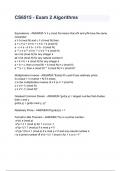
-
CS6515 - Exam 2 Algorithms questions and answers
- Exam (elaborations) • 14 pages • 2024
-
Available in package deal
-
- $7.99
- + learn more
Equivalence - ANSWER-"x ≡ y (mod N) means that x/N and y/N have the same remainder a ≡ b (mod N) and c ≡ d (mod N) then: a + c ≡ a + d ≡ b + c ≡ b + d (mod N) a - c ≡ a - d ≡ b - c ≡ b - d (mod N) a ** c ≡ a ** d ≡ b ** c ≡ b ** d (mod N) ka ≡ kb (mod N) for any integer k ak ≡ bk (mod N) for any natural number k a + k ≡ b + k (mod N) for any integer k a + b = c, then a (mod N) + b (mod N) ≡ c (mod N) a ** b = c, then a (mod N) ** b (mod N) ≡ c (mod N)...
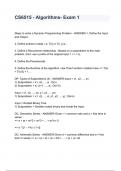
-
CS6515 - Algorithms- Exam 1 100% correct solution
- Exam (elaborations) • 3 pages • 2024
-
Available in package deal
-
- $7.99
- + learn more
Steps to solve a Dynamic Programming Problem - ANSWER-1. Define the Input and Output. 2. Define entries in table, i.e. T(i) or T(i, j) is... 3. Define a Recurrence relationship - Based on a subproblem to the main problem. (hint: use a prefix of the original input 1 < i < n). 4. Define the Pseudocode. 5. Define the Runtime of the algorithm. Use Time Function notation here => T(n) = T(n/2) + 1... DP: Types of Subproblems (4) - ANSWER-Input = x1, x2, ..., xn 1) Subproblem = x1, x2...

How did he do that? By selling his study resources on Stuvia. Try it yourself! Discover all about earning on Stuvia

